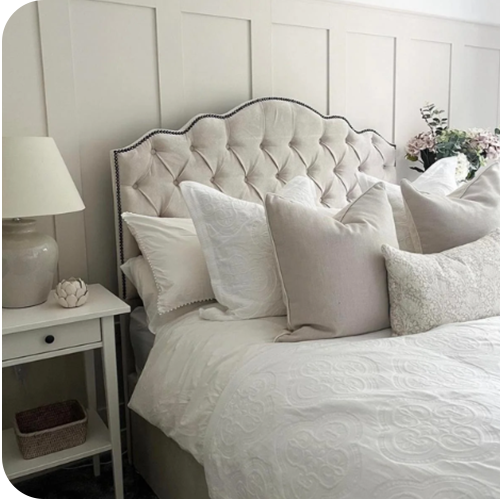How to Prevent Bed Headboards from Hitting the Wall
Picture this: you’re comfortably settled into bed, ready for a restful night’s sleep, only to be jolted awake by the loud thud of your headboard hitting the wall. It’s an all-too-common scenario that can disrupt your sleep and leave you feeling frustrated. But fear not! There are practical and effective ways to prevent your bed headboard from making unwanted contact with the wall, ensuring a peaceful night’s rest without disturbances.
Table of contents
What is a headboard: Why Do We Need it

A headboard is a piece of furniture attached to the head of a bed frame. Its primary function is decorative, serving as a focal point in a bedroom. Beyond aesthetics, it offers practical benefits by providing support and comfort when sitting up in bed, preventing pillows from slipping, and insulating against cold walls.
Functionally, it acts as a buffer between the wall and bed, reducing wear and tear. Moreover, headboards offer versatility in design, allowing personalization and complementing the room’s style. Ultimately, while not essential, a headboard adds both visual appeal and functional advantages to a bed setup.
Understanding the Problem: Why Does the Headboard Hit the Wall?

To address the issue effectively, it’s essential to understand why your headboard is making contact with the wall in the first place. Several factors contribute to this problem, including bed frame design, mattress size, room layout, and movement during sleep.

- Bed Frame Design: Inadequate support or improper installation can cause the bed frame to shift.
- Mattress Size: Larger mattresses or mismatched bed sizes can result in the headboard extending beyond the bed’s base.
- Room Layout: Limited space or incorrect positioning can contribute to headboard-wall collisions.
- Sleep Movements: Restless sleepers or vigorous movements during the night can cause the bed to shift.
Effective Strategies to Prevent Headboard-Wall Contact
Now that we’ve identified the culprits behind this nightly disturbance, let’s delve into effective solutions to prevent your bed headboard from hitting the wall. When it comes down to searching for some effective strategies, you might search over the internet for the answer.
However, the availability of massive information over the web may confuse you. Consequently, this leading you to make a wrong decision, Therefore, we have brought some useful information to help you save time.

|
Strategy |
Description |
| Adjust Bed Placement | Reposition the bed within the room to create space between the headboard and the wall. Ensure a few inches gap to prevent contact. |
| Install Wall Protectors | Attach soft padding or rubber stoppers to the wall to cushion the headboard and minimize noise and damage. |
| Utilize Anti-Slip Mats | Place anti-slip mats or grippers between the bed frame and mattress to enhance stability and prevent shifting during sleep. |
| Opt for a Headboard Stabilizer | Invest in a stabilizer or bracket to secure the headboard firmly to the bed frame, reducing excessive movement that causes contact. |
| Use Bed Frame Attachments | Explore attachments like straps or braces that provide additional support, keeping the bed and headboard in place and preventing collision. |
Conculsion
Bid farewell to those disruptive thuds disrupting your nights! Employing these pragmatic strategies guarantees a solution to your bed headboard hitting the wall, granting you undisturbed, tranquil sleep. By using padding or a rubber stopper between the headboard and the wall, adjusting bed positioning, or securing the headboard to the wall, you prevent annoying disturbances.
This proactive approach ensures a soundless environment, allowing you to enjoy uninterrupted slumber and wake up refreshed each morning. Embrace these simple fixes to bid adieu to the bothersome noise and embrace serene, uninterrupted sleep.
Readmore:
Benefits of Investing in a Luxury Bed
How to make a Bed look Luxurious?
Why Furniture Placement Matters
FAQs
If there are visible marks, scratches, or indentations on either the headboard or the wall, it’s likely causing damage. Implement preventive measures to avoid further issues.
Yes, upgrading to a sturdier or appropriately sized bed frame can eliminate the problem by providing better support and stability.
A thicker mattress might extend further, increasing the likelihood of contact. Ensure the mattress size is compatible with your bed frame to avoid this issue.
nd minimize noise.
Absolutely! DIY options include using adhesive-backed felt pads, foam bumpers, or even tennis balls attached to the wall to cushion impact a



